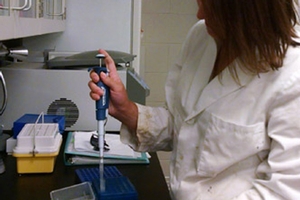Science
The Center for Behavioral Neuroscience: Advancing Discovery and Scientific Training

Sabrina Jones in the lab.
The Center for Behavioral Neuroscience, an interdisciplinary hub for research focused on understanding the brain and behavior, supports an increased focus on science, technology, engineering and math (STEM) activity at American University. The Center is comprised of faculty in the College of Arts & Sciences coming from a wide range of departments including psychology, biology, chemistry, mathematics and statistics, health studies, computer science, economics, and education.
Integration of multiple research areas allows both faculty and students to conduct ground-breaking research in areas such as drug addiction, obesity, learning and memory, decision making, vision science, language development, and traumatic brain injury. Many of these findings have been presented at national and international conferences and published in high impact journals. The Center has supported this work by providing state of the art core research equipment needed for electroencephalography (EEGs), optogenetics, immunohistochemistry, cell sorting, intracranial brain stimulation, and high-resolution confocal microscopy. Based on the work being done in Center laboratories, many faculty members associated with the Center are supported by external funding from the National Institutes of Health (NIH) and other federal agencies and private foundations. Within just the past year, 6 Center members were awarded new externally-funded grants.
The wide range of expertise among Center faculty members helps to support a multidisciplinary, collaborative program where students can individualize their education by combining different focus areas. Many of the students associated with the Center are working toward a doctoral degree in Behavior, Cognition, and Neuroscience. Students are able to utilize the core research equipment to learn new techniques and conduct novel experiments. Along with many students being recognized for their work at national and international conferences, one doctoral student, Linda Amarante, was awarded a highly competitive National Science Foundation Graduate Research Fellowship to support her work on value based decision-making. The Center has also started offering competitive internal summer research awards to fund doctoral candidates based on level of participation in Center activities, academic performance, and record of research productivity. Undergraduate students, often majoring in neuroscience, psychology, biology, or chemistry, also play an important role in the Center, assisting with research in many laboratories.
The Center has further made STEM a focus at AU by supporting a symposium in April 2017 hosted by Colin Saldanha and Terry Davidson, which addressed sex as a variable in scientific research. The speakers at the symposium were among the most nationally and internationally renowned experts in the field of sex differences in the brain and the implication of research on sex differences for human health and governmental policy. Among these experts were Center members, Anthony Riley and Colin Saldanha, who described their research on the role of sex differences in addiction and traumatic brain injury, respectively. The audience included scientists, faculty, and students from federal agencies (NIH, FDA, USDA) and from universities across the country. AU students and faculty members attended the symposium for free.
Along with larger symposiums, the Center hosts special lectures that bring in speakers from across the country. Talks have ranged from regeneration of sensory cells in the auditory system to the evolution of color vision in primates. These lectures are free to Center members, and allow students and faculty to interact with leading experts across multiple fields. As the Center continues to grow, the larger influence STEM has at AU which, in turn, increases AU's visibility within the scientific community.

